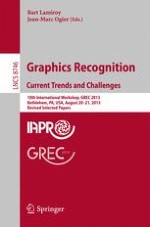This book constitutes the thoroughly refereed post-conference proceedings of the 10th International Workshop on Graphics Recognition, GREC 2013, held in Bethlehem, PA, USA, in August 2013.
The 20 revised full papers presented were carefully reviewed and selected from 32 initial submissions. Graphics recognition is a subfield of document image analysis that deals with graphical entities in engineering drawings, sketches, maps, architectural plans, musical scores, mathematical notation, tables, and diagrams. Accordingly the conference papers are organized in 5 topical sessions on symbol spotting and retrieval, graphics recognition in context, structural and perceptual based approaches, low level processing, and performance evaluation and ground truthing.
